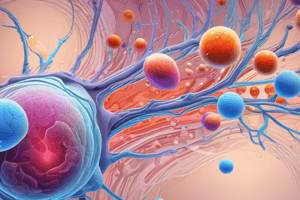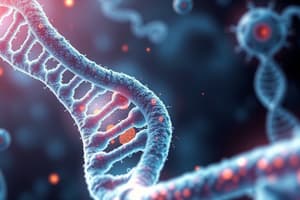Podcast
Questions and Answers
What role does endonuclease G play in the apoptotic process?
What role does endonuclease G play in the apoptotic process?
- It causes DNA fragmentation. (correct)
- It triggers chromatin condensation.
- It activates phagocytosis.
- It enhances mitochondrial respiration.
Which phase of apoptosis is characterized by the fragmentation of the nucleus?
Which phase of apoptosis is characterized by the fragmentation of the nucleus?
- Degradation phase (correct)
- Initiation phase
- Phagocytic phase
- Recognition phase
Phagocytosis of apoptotic cells is primarily facilitated by which alteration in the cell membrane?
Phagocytosis of apoptotic cells is primarily facilitated by which alteration in the cell membrane?
- Increased ATP levels
- High levels of reactive oxygen species
- Mitochondrial depolarization
- Phosphatidyl serine exposure (correct)
What physiological change does the permeability transition pore complex cause?
What physiological change does the permeability transition pore complex cause?
Which of the following enzymes are mainly activated during the degradation phase of apoptosis?
Which of the following enzymes are mainly activated during the degradation phase of apoptosis?
What is a common morphological change during the degradation phase of apoptosis?
What is a common morphological change during the degradation phase of apoptosis?
What occurs during the phagocytic phase of apoptosis?
What occurs during the phagocytic phase of apoptosis?
In which phase do chromatin endonucleases fragment the nucleosomes?
In which phase do chromatin endonucleases fragment the nucleosomes?
Which type of cells continuously divide and include surface epithelial cells of the skin?
Which type of cells continuously divide and include surface epithelial cells of the skin?
What type of stem cell can differentiate into any human tissue, but does not support the full development of an organism?
What type of stem cell can differentiate into any human tissue, but does not support the full development of an organism?
Permanent nondividing cells include which of the following?
Permanent nondividing cells include which of the following?
What primarily regulates the process of cellular differentiation?
What primarily regulates the process of cellular differentiation?
What is the main premise of programmed theories of aging?
What is the main premise of programmed theories of aging?
What does the programmed longevity sub-category of the programmed theory suggest about aging?
What does the programmed longevity sub-category of the programmed theory suggest about aging?
Which cells can be induced to reenter the cell cycle when exposed to growth factors?
Which cells can be induced to reenter the cell cycle when exposed to growth factors?
Which theory proposes that an accumulation of free radicals leads to aging?
Which theory proposes that an accumulation of free radicals leads to aging?
Which stem cell type has the potential to differentiate into a limited number of cell types within a specific lineage?
Which stem cell type has the potential to differentiate into a limited number of cell types within a specific lineage?
What is the main focus of the endocrine theory in the context of aging?
What is the main focus of the endocrine theory in the context of aging?
What distinguishes different cell types despite all cells containing the same genome?
What distinguishes different cell types despite all cells containing the same genome?
What does the somatic DNA damage theory suggest about cellular aging?
What does the somatic DNA damage theory suggest about cellular aging?
Which of the following outcomes is primarily associated with the immunological theory of aging?
Which of the following outcomes is primarily associated with the immunological theory of aging?
The rate of living theory is based on which of the following premises regarding lifespan?
The rate of living theory is based on which of the following premises regarding lifespan?
What aspect of aging does the wear and tear theory emphasize?
What aspect of aging does the wear and tear theory emphasize?
Which of the following macromolecules is NOT mentioned as being susceptible to free radical damage according to the free radicals theory?
Which of the following macromolecules is NOT mentioned as being susceptible to free radical damage according to the free radicals theory?
What can damage to mitochondrial DNA potentially lead to?
What can damage to mitochondrial DNA potentially lead to?
What is the role of apoptosis in the interdigital cell death of a mouse embryo?
What is the role of apoptosis in the interdigital cell death of a mouse embryo?
During which phase of development does apoptosis occur in a tadpole?
During which phase of development does apoptosis occur in a tadpole?
What is the primary trigger for the extrinsic pathway of apoptosis?
What is the primary trigger for the extrinsic pathway of apoptosis?
Which component is released by Bax and Bak during the intrinsic pathway of apoptosis?
Which component is released by Bax and Bak during the intrinsic pathway of apoptosis?
What does the release of cytochrome c lead to in the intrinsic apoptosis pathway?
What does the release of cytochrome c lead to in the intrinsic apoptosis pathway?
What is one of the outcomes of activated caspase 9 in the cell?
What is one of the outcomes of activated caspase 9 in the cell?
What is a common feature between intrinsic and extrinsic apoptosis pathways?
What is a common feature between intrinsic and extrinsic apoptosis pathways?
What is the primary mechanism by which genes are turned 'on' or 'off'?
What is the primary mechanism by which genes are turned 'on' or 'off'?
Which type of stem cell can give rise to any of the 220 cell types found in an embryo?
Which type of stem cell can give rise to any of the 220 cell types found in an embryo?
What role do transcription factors play in cellular differentiation?
What role do transcription factors play in cellular differentiation?
How do multipotent stem cells differ from pluripotent stem cells?
How do multipotent stem cells differ from pluripotent stem cells?
Which statement is true regarding stem cell potency?
Which statement is true regarding stem cell potency?
What is the role of RNA polymerase in the context of gene expression?
What is the role of RNA polymerase in the context of gene expression?
Which type of stem cell cannot give rise to extra-embryonic cells?
Which type of stem cell cannot give rise to extra-embryonic cells?
What determines which genes will be expressed in a cell?
What determines which genes will be expressed in a cell?
Flashcards are hidden until you start studying
Study Notes
Cell Differentiation
- Cell differentiation is a process where cells specialize into one of hundreds of different cell types in the human body.
- Transcription Factors are proteins that bind to specific parts of DNA and regulate gene expression.
- Transcription Factors either promote or inhibit the transcription of genes.
Cell Potency
- Cell potency refers to the ability of stem cells to differentiate into specialized cell types.
- Totipotent cells can differentiate into any cell type in the body, as well as extra-embryonic cells like the placenta.
- Pluripotent cells can differentiate into any cell type in the body, but not the placenta.
- Multipotent cells can only differentiate into a limited number of cell types within a specific lineage.
Proliferative Capability
- Labile cells continuously divide, like surface epithelial cells of the skin and epithelial cells of the gastrointestinal tract.
- Stable cells do not typically divide but can be induced to do so with growth factors, like parenchymal cells of the liver, kidney, and pancreas.
- Permanent cells have lost the ability to proliferate, like nerve cells and cardiac muscle cells.
Cellular Aging
- Cellular aging theories fall into two categories: programmed theories, which suggest aging follows a biological timetable, and damage or error theories, which emphasize environmental damage.
- Programmed Longevity is the idea that aging occurs sequentially due to gene expression changes.
- Endocrine Theory suggests that aging is regulated by hormones.
- Immunological Theory proposes that the immune system declines with age, leading to increased vulnerability to disease.
- Wear and Tear Theory suggests that cells and tissues wear out with time.
- Rate of Living Theory proposes that a higher metabolic rate leads to a shorter lifespan.
- Cross-Linking Theory suggests that the accumulation of cross-linked proteins damages cells.
- Free Radicals Theory suggests that free radicals cause damage to cellular components.
- Somatic DNA Damage Theory suggests that the accumulation of DNA damage leads to cellular dysfunction.
Apoptosis
- Apoptosis is the programmed cell death that helps regulate cell numbers and eliminate unwanted cells.
- Apoptosis during tadpole metamorphosis leads to the loss of the tail as the tadpole transforms into a frog.
Pathways of Apoptosis
- There are two major pathways of apoptosis: intrinsic (mitochondrial) pathway and extrinsic (death receptor) pathway.
- Intrinsic Pathway is activated by internal surveillance mechanisms leading to the release of cytochrome c, which activates caspases.
- Caspases disassemble the cell, causing fragmentation and death.
- Extrinsic Pathway is triggered by signals from other cells.
Stages of Apoptosis
- There are four stages of apoptosis:
- Initiation
- Execution
- Degradation
- Phagocytic
- Degradation Phase: enzymatic mechanisms are activated, proteins are cross-linked or broken, DNA is degraded, and the cell surface is altered.
- Phagocytic Phase: macrophages recognize and engulf apoptotic cells, preventing an inflammatory response.
Sequential Events in Apoptosis
- Apoptosis typically affects individual cells.
- Apoptosis is a precisely regulated process that ensures a clean and controlled removal of cells.
Studying That Suits You
Use AI to generate personalized quizzes and flashcards to suit your learning preferences.




